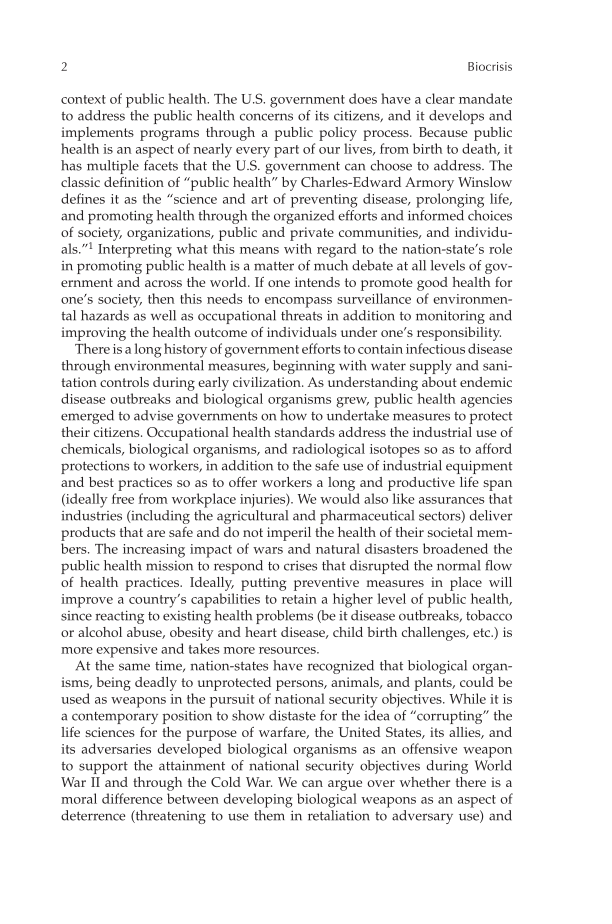2 Biocrisis context of public health. The U.S. government does have a clear mandate to address the public health concerns of its citizens, and it develops and implements programs through a public policy process. Because public health is an aspect of nearly every part of our lives, from birth to death, it has multiple facets that the U.S. government can choose to address. The classic definition of “public health” by Charles-Edward Armory Winslow defines it as the “science and art of preventing disease, prolonging life, and promoting health through the organized efforts and informed choices of society, organizations, public and private communities, and individu- als.”1 Interpreting what this means with regard to the nation-state’s role in promoting public health is a matter of much debate at all levels of gov- ernment and across the world. If one intends to promote good health for one’s society, then this needs to encompass surveillance of environmen- tal hazards as well as occupational threats in addition to monitoring and improving the health outcome of individuals under one’s responsibility. There is a long history of government efforts to contain infectious disease through environmental measures, beginning with water supply and sani- tation controls during early civilization. As understanding about endemic disease outbreaks and biological organisms grew, public health agencies emerged to advise governments on how to undertake measures to protect their citizens. Occupational health standards address the industrial use of chemicals, biological organisms, and radiological isotopes so as to afford protections to workers, in addition to the safe use of industrial equipment and best practices so as to offer workers a long and productive life span (ideally free from workplace injuries). We would also like assurances that industries (including the agricultural and pharmaceutical sectors) deliver products that are safe and do not imperil the health of their societal mem- bers. The increasing impact of wars and natural disasters broadened the public health mission to respond to crises that disrupted the normal flow of health practices. Ideally, putting preventive measures in place will improve a country’s capabilities to retain a higher level of public health, since reacting to existing health problems (be it disease outbreaks, tobacco or alcohol abuse, obesity and heart disease, child birth challenges, etc.) is more expensive and takes more resources. At the same time, nation-states have recognized that biological organ- isms, being deadly to unprotected persons, animals, and plants, could be used as weapons in the pursuit of national security objectives. While it is a contemporary position to show distaste for the idea of “corrupting” the life sciences for the purpose of warfare, the United States, its allies, and its adversaries developed biological organisms as an offensive weapon to support the attainment of national security objectives during World War II and through the Cold War. We can argue over whether there is a moral difference between developing biological weapons as an aspect of deterrence (threatening to use them in retaliation to adversary use) and
Document Details My Account Print multiple pages
Print
You have printed 0 times in the last 24 hours.
Your print count will reset on at .
You may print 0 more time(s) before then.
You may print a maximum of 0 pages at a time.



































































































































































































































































































